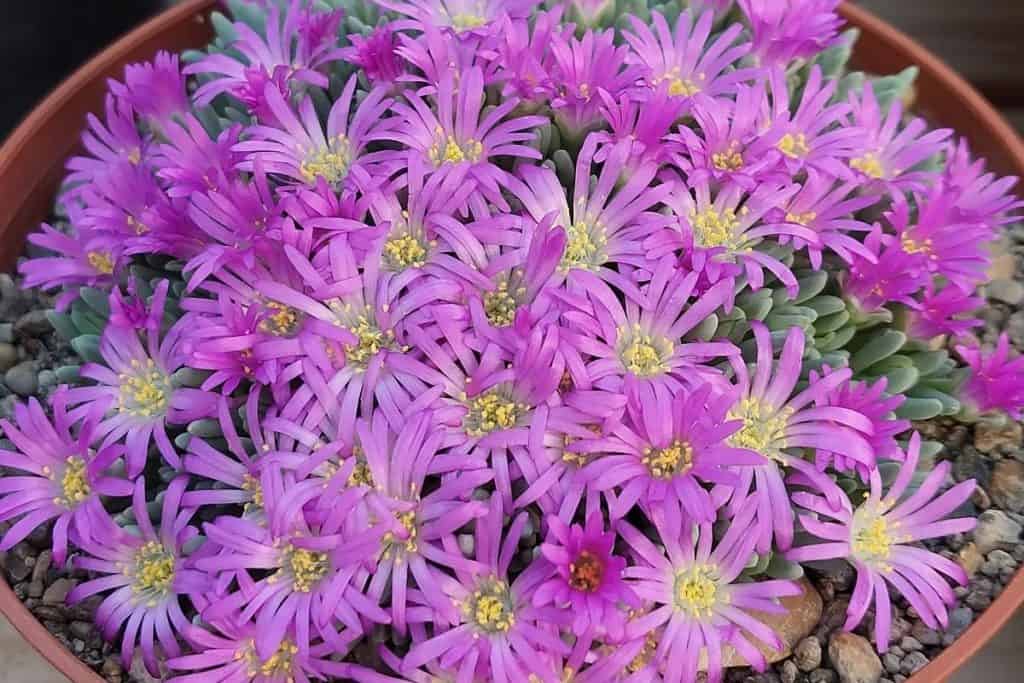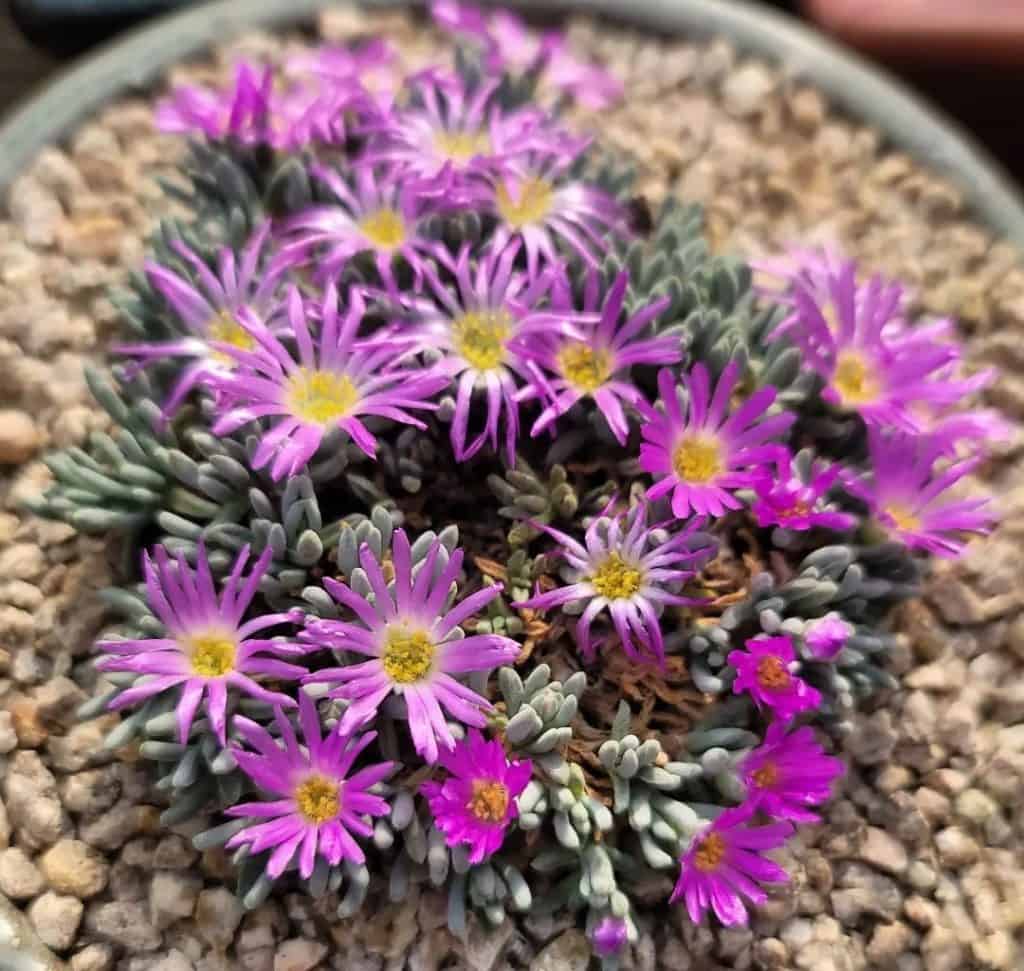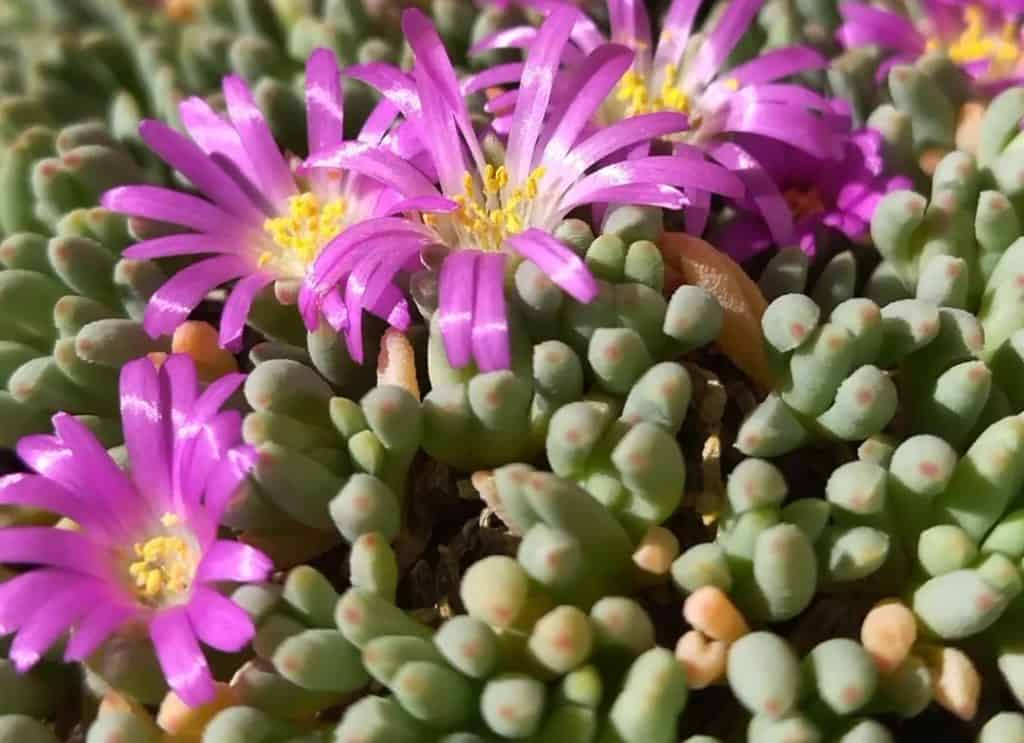Delosperma sphalmanthoides: Characteristics and Care
Ever heard of a plant that looks like a tiny, fuchsia-colored sea anemone hugging the ground? Well, let me introduce you to the utterly charming Delosperma sphalmanthoides, affectionately known as the dwarf sea anemone or tufted ice plant. This little marvel from South Africa’s Cape Province is about to become your new gardening obsession!

Contents
About Delosperma sphalmanthoides
The Delosperma sphalmanthoides belongs to the Aizoaceae family and is a true showstopper despite its diminutive size. While it may only grow to a height of 2-4 inches, this ground-hugging beauty can spread up to a foot wide, creating a vibrant, fleshy carpet of cylindrical leaves and eye-catching magenta or fuchsia flowers that tower above the foliage.
Related Post:
1,000 Types of Succulents With Pictures
How to Care for Delosperma sphalmanthoides
Light Requirements
One of the best things about the tufted ice plant is its versatility – it thrives equally well outdoors in sunny, sheltered spots or indoors as a container plant. If growing it inside, just make sure to place the pot in a location that receives plenty of bright, direct sunlight. You can even use a grow light to supplement natural light if needed.
Watering Needs
During the spring and summer, your Delosperma sphalmanthoides will appreciate a good weekly watering to keep the soil slightly moist. But come winter, it’s perfectly content with drier conditions. In fact, if you live in an area with snowy winters, it’s best to cover the plant with a frost blanket or row cover to keep the crowns and foliage nice and dry.
Soil Preferences
When it comes to soil, this plant likes it well-draining and on the gritty side. Sandy, gravelly, or sandy loam mixes are ideal, while clay-heavy soils are a big no-no. To improve drainage, you can top-dress with a layer of gravel mulch, bark chips, or pine needles. And if you’re in a drier climate, regular garden loam should work just fine.

Fertilizing for Success
Here’s the deal – the tufted ice plant isn’t a big fan of frequent feedings during its growing season. In fact, too much fertilizer can lead to winter kill. Instead, give it a light dose of an organic or natural fertilizer in the fall, and it’ll be one happy camper.
Temperature and Humidity
As a xeric (dry-loving) perennial, the Delosperma sphalmanthoides thrives in warm, sunny conditions with low humidity. It’s cold-hardy down to USDA zones 4-5, where it may act as an annual, but truly shines as a long-lived beauty in the drier climates of zones 6-8.
Pests and Problems
While generally hardy and disease-resistant, your tufted ice plant may occasionally play host to uninvited guests like mealybugs, vine weevils, or aphids. Keep an eye out for these pests and take appropriate action if needed.
Pruning for Perfection
To keep your plant looking its best, give it a little trim after the blooms fade in fall. Use sharp pruners to remove spent flowers, cut back any scraggly growth to a uniform height, and tidy up dead foliage. This’ll not only prevent self-seeding but also maintain that vibrant, tidy appearance you love. And if winter proves too harsh, simply cut the plant back to the ground – it’ll bounce back in spring, good as new!
Potting and Repotting
When you first bring home your Delosperma sphalmanthoides, be sure to repot it right away in a well-draining potting mix. Then, every couple of years (or when it’s outgrown its digs), give it a fresh start in a new container with fresh soil.

How to Propagate Delosperma sphalmanthoides
The best part about the tufted ice plant? It’s an eager self-seeder, happily spreading itself around year after year without any help from you. But if you’d like to lend a hand, propagation is a breeze via seeds, cuttings, or division:
Seeds:
- Prepare the soil by raking and exposing it, then water lightly
- Scatter seeds on the surface and gently press them into the soil
- Don’t cover the seeds, as they need light to germinate
Cuttings:
- Take 2-4 inch stem cuttings, removing lower leaves to expose at least one node
- Allow cuttings to callus over for a few days
- Insert cut ends into moist soil and place in bright, indirect light for a week
- Once new growth appears, move to direct sun and transplant to desired location
Division:
- When repotting, simply separate the rootball into two or more clumps
- Plant each division in its own container with fresh, well-draining potting mix
And there you have it, folks – everything you need to know about growing and caring for the delightful Delosperma sphalmanthoides. This low-maintenance marvel is sure to add a pop of color and whimsy to any garden or indoor space. So what are you waiting for? Get your hands on this tufted ice plant and let the fun begin!
